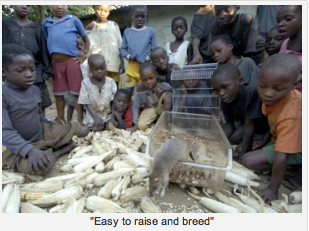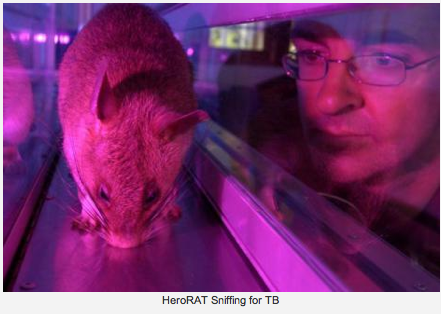Shift continents and the villain becomes a hero. In fact, a “HeroRAT,” with a genius for sniffing out landmines and diagnosing TB.
Maybe. But on the HeroRAT website, you can read all about Allan, Chosen One, Kim and Ziko, and even Adopt-a-Rat. In their own little pouchy way, they’ve got Ratatouille charisma. Jane Goodall’s a big fan.
They’re pretty efficient, too. In 30 minutes, a rat can sniff out an area that otherwise would take a couple of days to clear. And they’re just as good at detecting plastic mines as metal ones.
There are an estimated 100 million landmines in over 90 countries, so the scale of the problem is beyond daunting. Using existing technology, it would take centuries to remove all the mines. In the meantime, dozens of people are maimed and killed each day, while social fabric fractures when people are kept from their homes and farmland is kept out of production.
Still, as I read about interest in using HeroRats beyond their native Africa, my thoughts went back to 2003 and a sick little girl in Wisconsin who sparked a bioterror scare.
Giant Gambian pouched rats had become popular pets, a development that would, no doubt, have amazed and amused Africans who generally see them as pests, or possibly dinner.
It started when a shipment from Ghana of 800 animals (9 species), including some clinically-healthy but infected pouched rats, was delivered to an outfit in Texas. The rats were then sold to a vendor in Iowa, who sold them to a dealer in Illinois, who also stocked prairie dogs. The rats infected the prairie dogs, which were then shipped to at least a dozen other states. The prairie dogs began falling ill (a rodent replay of what happened to American Indians after exposure to the smallpox virus carried by Europeans). At least one sick “doggie” ended up at a swap meet in Wisconsin, where a little girl bought it, was promptly scratched and became ill. The specter of monkeypox made the West Nile virus outbreak look like child’s play. Fear drove speculation: Was it bioterrorism? Would the virus infect wildlife and become endemic? What about person-to-person spread? Were sick patients a risk to doctors and nurses?
Thanks to some phenomenal epidemiological legwork and some lucky breaks (no person-to-person transmission), the outbreak was contained and panic faded. Monkeypox devolved into a harmless punchline on late night talk shows.
Imports of giant African pouched rats were, of course, quickly banned, but hundreds, if not thousands, were already here. Escaped rats had begun to roam wild and multiply all over Grassy Key, Florida – Jimmy Buffet territory. Last year, the Florida Depart of Natural Resources mounted what was supposed to be a final campaign to eradicate them. It didn’t work. A native Grassy Keysian I spoke with today reported seeing a rat on her driveway recently that was so big, she thought it was a cat at first. They are so big, actual cats won’t take them on.
Naturalists worry the rats will eventually find their way into the Everglades, with devastating implications. Whether as a carrier of an invasive disease, or as an invasive species infecting an ecosystem, giant African pouched rats pose a significant biothreat. That’s an important consideration for HeroRATS deployed outside of Africa.
Still, as long as they’re here, perhaps we should put them to work. HeroRATS are also being trained at the Apopo lab in Tanzania to sniff for the tell-tale scent of tuberculosis in human sputum.
| The standard microscope test is both time-consuming and pricey. A rat can zip through 40 samples in 10 minutes with an 85+% accuracy rate, according to early tests. It would take a lab tech at least a day to do the same. Rats have even correctly diagnosed samples missed by microscopy. Considering that nearly 30% of all new TB cases are in Africa, a local, scalable solution for cheap rapid diagnostics is clear winner. The Skoll Foundation thinks so, too, and gave Apopo a $1 million grant for social entrepreneurship last August. With funding now secure, hordes of HeroRATS will be trained to sniff for all sorts of trouble. Imagine that: Saved by rats.
|











